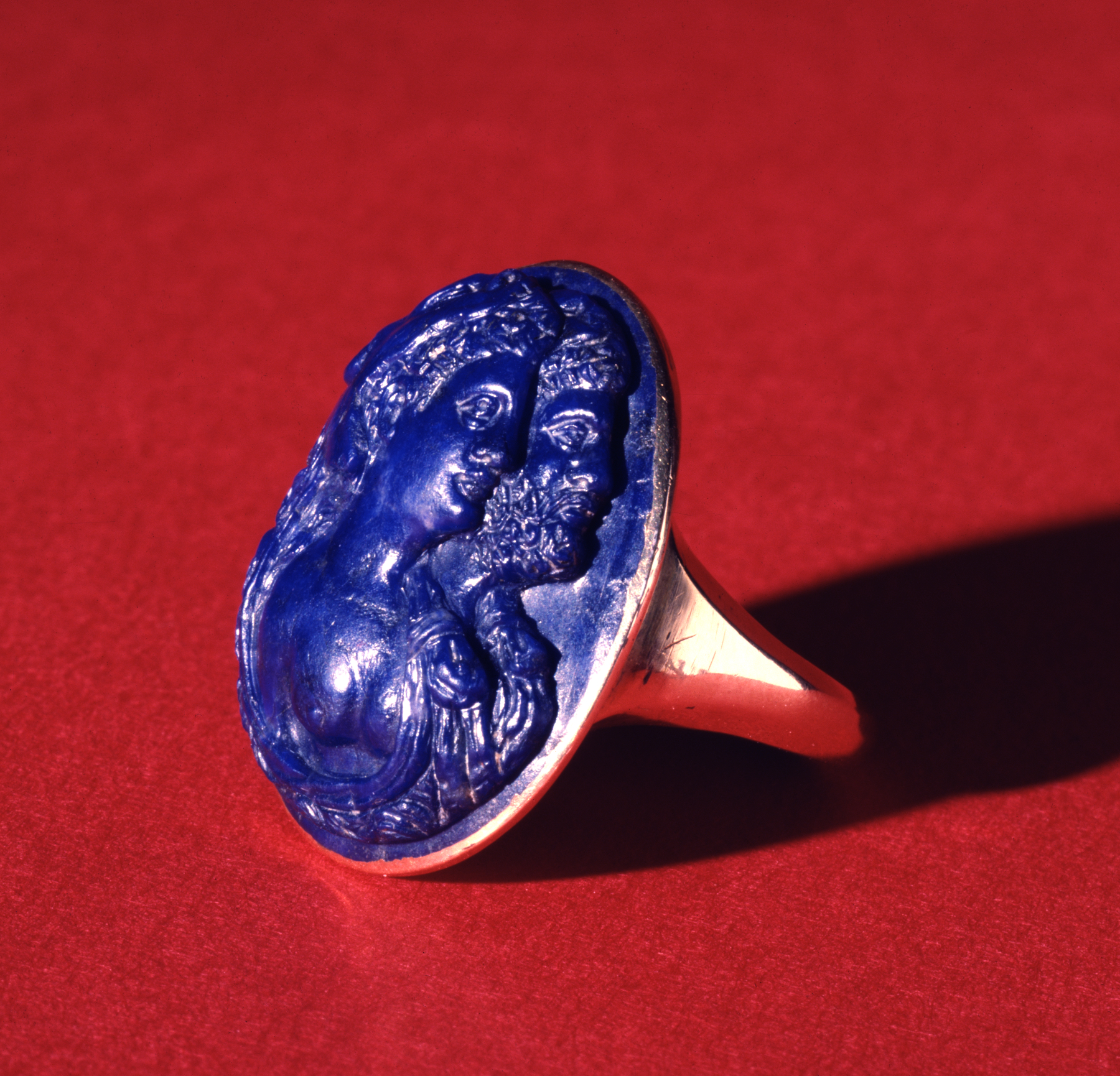Cameo with Hercules and Omphale
(Renaissance Europe )
Omphale, queen of Lydia, wears Hercules' lion skin and exposes one breast. With a later gold mount (as a ring). this cameo carved from precious lapis (from Afghanistan) belonged to a member of the Orsini family in the late 1500s in rome, from whom it was purchased by Thomas Howard Earl of Arundel, an important English collector and diplomat. The carved gems of the Earl were subsequntly acquired by the Dukes of Marlborough. See the discussion of the Arundel gem collection and that of the Marlboroughs on the Chamber of Wonders microsite. Maor holdings of these t wo collections are now in the Walters with an unbroken provenance going back to these collectors. In the case of this gem to the 1500s.
Provenance
Provenance (from the French provenir, 'to come from/forth') is the chronology of the ownership, custody, or location of a historical object. Learn more about provenance at the Walters.
Thomas Howard, fourteenth/twenty-first Earl of Arundel, Arundel House, London, 1638, by purchase [William Petty as agent] [Arundel Collection C, no. 9]; Aletheia Talbot Howard, Arundel House, London, 1646, by bequest; Henry Frederick Howard, fifteenth/twenty-second Earl of Arundel, Arundel House, London, by 1652, by gift; Henry Howard, sixth Duke of Norfolk, Arundel House, London, 1652, by bequest; Jane Bickerton Howard, Arundel House, London, 1684, by bequest; Henry Mordaunt, second Earl of Peterborough, by 1690, by purchase; Mary Mordant, Drayton House, Northamptonshire, 1697, by bequest; John Germain, Drayton House, Northamptonshire, 1705, by bequest; Elizabeth Germain, Knole House, Kent, 1718, by bequest; Mary Beauclerk Spencer, 1762, by gift; George Spencer, fourth Duke of Marlborough, Blenheim Palace, Oxfordshire, ca. 1765, by gift [Marlborough no. 319]; George Spencer-Churchill, fifth Duke of Marlborough, Blenheim Palace, Oxfordshire, 1817, by bequest; George Spencer-Churchill, sixth Duke of Marlborough, Blenheim Palace, Oxfordshire, 1840, by bequest; John Spencer-Churchill, seventh Duke of Marlborough, Blenheim Palace, Oxfordshire, 1857, by bequest; Sale, The Marlborough Gems, Christie, Manson & Woods, London, 28 June 1875, p. 51, lot 319; David Bromilow, Bitteswell Hall, Leicestershire, ca. 1875, by purchase; Julia Bromilow Jary, Bitteswell Hall, Leicestershire, 1898, by bequest; Sale, The Marlborough Gems Purchased by the Late David Bromilow, esq., Christie, Manson & Woods, London, 26 June 1899, p. 58, lot 319; Henry Walters, Baltimore, 1899, by purchase [Dikran Kelekian as agent]; Sadie Jones (Mrs. Henry Walters), New York, 1931, by bequest; Joseph Brummer, Paris and New York, 1941, by purchase [Brummer inv. no. N5143a]; Walters Art Museum, 1942, by purchase.
Exhibitions
| 1979-1980 | Jewelry - Ancient to Modern. The Walters Art Gallery, Baltimore. |
Conservation
| Date | Description | Narrative |
|---|---|---|
| 2/9/1979 | Examination | examined for condition |
| 7/17/1980 | Treatment | examined for exhibition |
| 7/28/1980 | Examination | examined for condition |
Geographies
Italy (Place of Origin)
Measurements
H: 1 × W: 13/16 × D: 1 in. (2.5 × 2 × 2.5 cm)
Credit Line
Museum purchase [formerly part of the Walters Collection], 1942
Location in Museum
Accession Number
In libraries, galleries, museums, and archives, an accession number is a unique identifier assigned to each object in the collection.
In libraries, galleries, museums, and archives, an accession number is a unique identifier assigned to each object in the collection.
42.1057


